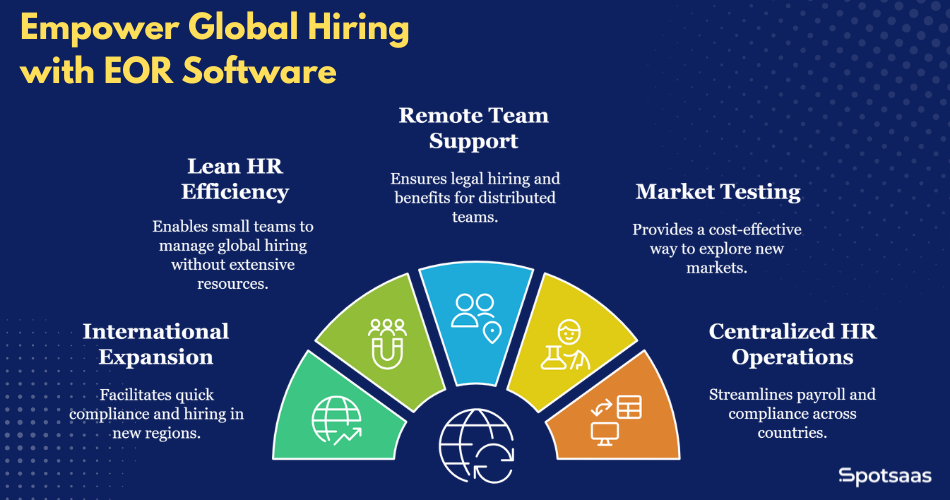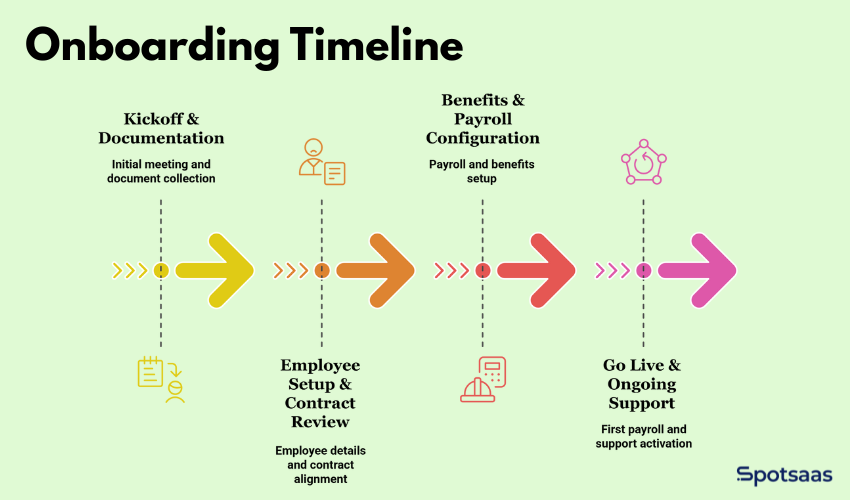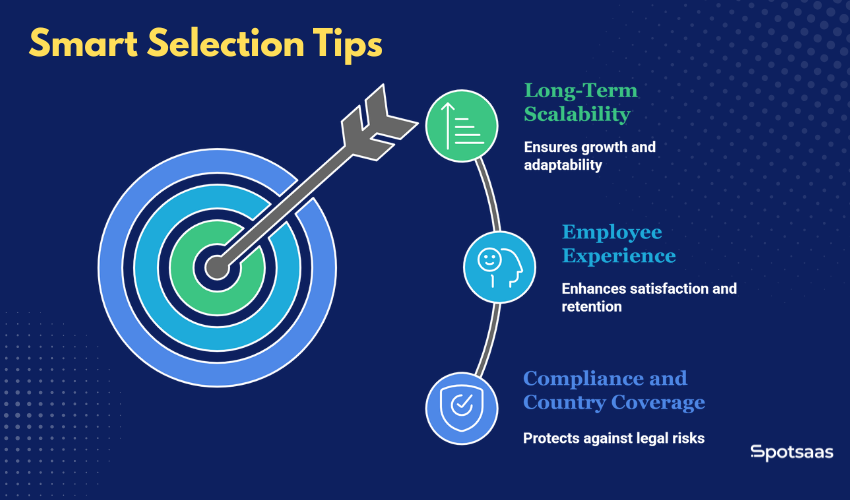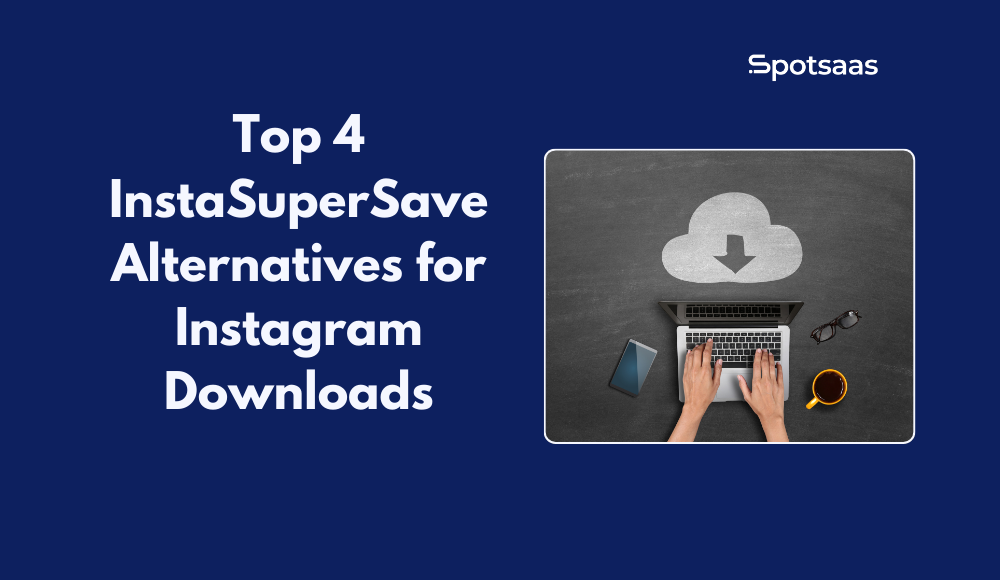A well-structured comparison checklist is essential when expanding your team across borders. From managing payroll and local taxes to staying compliant with labor laws, handling international employees requires more than just good intentions—it requires the right support.
That’s where Employer of Record (EOR) software plays a key role.
EOR softwares enable businesses to legally hire and manage talent in countries where they don’t have a legal entity. These platforms handle onboarding, payroll, benefits, and compliance—so teams can scale without operational delays.
This guide is crafted for HR professionals, global hiring leads, startup founders, and compliance teams who want to evaluate EOR options with clarity.
To help, we’ve built a practical comparison checklist that covers everything from compliance and payroll to employee support and pricing.
What This Blog Covers
This comparison checklist guide is designed to help you confidently evaluate and choose the right EOR software for your global hiring needs.
Here’s what you’ll find in this blog:
- Understand the types of businesses that benefit most from EOR software with real-world scenarios.
- A structured breakdown of the key categories to compare—compliance, payroll, tech, support, and more.
- See how leading EOR softwares like Deel, Rippling, and Remote stack up on key features.
- Learn the pitfalls of managing global hiring without legal infrastructure or support.
- A visual table to help you evaluate the pros and cons of managing employment independently vs using an EOR Software.
- A week-by-week onboarding comparison checklist to understand what happens after you choose a provider.
- Key factors to consider beyond pricing—like employee experience, compliance coverage, and scalability.
- Quick answers to common questions about EORs, including legal compliance, speed to hire, and benefits handling.
Who Needs EOR Software?
EOR software is built for companies looking to expand internationally without the delays, costs, and complexity of setting up local legal entities. It provides a scalable, compliant way to onboard and manage global employees—ideal for businesses that prioritize speed, flexibility, and control.

Companies Hiring in New Countries
If your company is entering new regions for the first time, you’ll need to comply with local labor laws, tax systems, and employment regulations. Setting up a local entity can take several months and may not be worth the investment for small teams or early market entry.
EOR providers act as the legal employer, allowing you to hire local talent in days—not months—while managing all legal and administrative responsibilities behind the scenes.
Startups with Lean HR Teams
Start-ups often operate with limited internal resources, especially in HR and legal. When hiring internationally, the stakes are higher—mistakes in employment contracts or tax filings can have serious consequences.
An EOR software allows small teams to manage global hiring without needing in-house legal or compliance experts, making it easier to focus on product, customers, and growth.
Remote-First or Distributed Teams
Remote work has made global hiring more accessible, but it also brings challenges. Employment laws vary from one country to another, and ensuring fair compensation, local benefits, and proper tax handling becomes difficult at scale.
EOR software bridges this gap, enabling remote-first companies to hire anywhere legally, offer competitive local benefits, and build trust with international team members.
Businesses Testing New Markets
Some companies need to staff small teams for pilot programs, client projects, or short-term contracts in new countries. In these cases, creating a legal entity may be unnecessary or inefficient.
EOR software offers a low-risk, cost-effective way to explore new markets, hire local talent quickly, and maintain compliance throughout the project lifecycle.
Teams Looking to Centralize HR Operations
Managing multiple vendors for payroll, compliance, benefits, and contracts across different countries can lead to fragmented workflows and communication gaps.
With EOR software, everything is centralized in one platform, giving HR teams better visibility, control, and consistency in managing global employees.
Comparison Checklist Categories
To help readers evaluate EOR software confidently, this section will break down the core comparison points.
- Global Coverage & Compliance
- Employee Experience
- Payroll & Tax Management
- Technology & Integration
- Pricing & Contract Transparency
- Customer Support & SLAs
- Data Security & Compliance Standards
| Category | Description | Questions to Ask |
|---|---|---|
| Global Coverage & Compliance | Support for your target countries with legal and tax alignment. |
|
| Employee Experience | Smooth onboarding, local benefits, and multilingual support. |
|
| Payroll & Tax Management | Accurate multi-country payroll with automated tax handling. |
|
| Technology & Integration | User-friendly dashboard and integration with HR tools. |
|
| Pricing & Contract Transparency | Clear pricing, flexible terms, and detailed invoicing. |
|
| Customer Support & SLAs | Reliable support with defined SLAs and local availability. |
|
| Data Security & Compliance | Certified systems for secure data handling and privacy. |
|
Global Coverage & Compliance
One of the most important aspects of EOR software is its ability to support the countries where you plan to hire. Each region comes with its own employment laws, tax systems, and regulatory frameworks, which require deep local expertise.
A reliable EOR provider should:
- Have active legal entities or partners in your target countries
- Stay up to date with regional labor laws and policy changes
- Handle employment contracts, benefits, taxes, and terminations per local regulations
- Ensure IP protection and risk mitigation in international employment
You’ll also want to check how frequently the provider expands into new regions, and whether their legal infrastructure is owned or partner-based. This directly affects control, service speed, and accountability.
Questions to ask:
- Which countries do you actively support?
- Do you operate through your own entities or third parties?
- How do you stay updated on regulatory changes in each country?
Employee Experience
While compliance and EOR payroll are critical, the experience your international employees have with the EOR provider can make or break retention. A smooth onboarding, clear communication, and access to localized benefits go a long way in building trust with your global team.
Look for EOR software that:
- Offers a seamless onboarding process with clear timelines and document collection
- Provides locally competitive benefits such as healthcare, pension plans, and paid leave
- Delivers timely payslips in the employee’s local language and currency
- Has support channels in the employee’s time zone and language
- Offers a self-service portal for pay history, benefits, and documents
The goal is to ensure employees feel valued and supported, even if they’re working far from your headquarters.
Questions to ask:
- How long does onboarding typically take in [target country]?
- What local benefits are included in your employment package?
- How do employees access their payroll and HR information?
Payroll & Tax Management
Accurate, timely payroll is non-negotiable. Make sure the EOR platform can handle complex, multi-country payroll and tax compliance with ease.
What to look for:
- Multi-currency payroll processing
- Automatic tax calculations and filings
- Payslips that are transparent and easy to understand
- Reimbursements, bonuses, and other add-ons handled smoothly
Questions to ask:
- How do you manage payroll differences between countries?
- What systems are in place for local tax compliance?
- Can you support bonus structures or expense reimbursements?
Technology & Integration
A user-friendly platform backed by automation can save your HR and finance teams valuable time. The best EOR providers offer simple interfaces and integration options.
What to look for:
- Central dashboard for HR, payroll, and compliance tracking
- Self-service access for both employers and employees
- Integrations with tools like HRIS, ATS, accounting platforms
- Real-time reporting and data exports
Questions to ask:
- Is the platform self-serve or service-led?
- What integrations do you support?
- Can we generate custom reports?
Pricing & Contract Transparency
EOR pricing models can vary—some charge per employee, while others have country-specific rates or bundled services. It’s important to understand exactly what’s included.
What to look for:
- Clear, upfront pricing with no hidden fees
- Breakdown of costs: salary, employer taxes, admin fees
- Flexible contract terms without long lock-ins
- Transparent invoicing and billing frequency
Questions to ask:
- What’s your pricing model, and what does it include?
- Are there any setup, offboarding, or exit fees?
- Can you share a sample invoice?
Customer Support & SLAs
Hiring globally means working across time zones. Make sure the EOR provider offers consistent support with defined service standards.
What to look for:
- Dedicated account manager or support team
- Local support teams available during business hours
- Clear service level agreements (SLAs) for onboarding, payroll, and issue resolution
- Multi-channel support (email, phone, chat)
Questions to ask:
- Who will be our main point of contact?
- What are your response and resolution timeframes?
- Do you offer regional support teams?
Data Security & Compliance Standards
When dealing with employee data and payroll records across multiple countries, data security isn’t optional—it’s critical.
What to look for:
- Compliance with GDPR, SOC 2, ISO 27001, or local equivalents
- Secure document storage and encryption
- Role-based access control for employers and employees
- Regular audits and third-party security assessments
Questions to ask:
- What certifications do you hold for data protection?
- Where is employee data stored?
- How do you handle data access and security breaches?
Side-by-Side Comparison Table
| Feature Category | Deel | Rippling | Remote |
|---|---|---|---|
| Global Coverage | 100+ countries supported | 50+ countries (via partners) | 70+ countries with owned entities |
| Onboarding Time | 2–5 business days | Varies by country | 2–6 business days |
| Payroll & Taxes | Multi-currency, automated | Integrated with payroll stack | Localized tax compliance |
| Employee Benefits | Localized benefits options | US-focused, add-ons for global | Country-specific packages |
| Tech & Integrations | Standalone platform | Deep integration with HRIS & IT | Dashboard + API access |
| Pricing Transparency | Per employee per month | Varies by country + platform fee | Transparent pricing by country |
| Support & SLAs | 24/7 global support | Regional account managers | Dedicated support team |
| Compliance & Security | GDPR, SOC 2, ISO certified | SOC 2 compliant | GDPR, SOC 2, ISO certified |
Compliance Risks of Not Using EOR
Hiring talent in another country without a proper legal structure can expose your business to significant risks. Many companies assume they can manage contracts, payroll, and benefits informally or through freelancers—but this approach often leads to unintended consequences.
Here are some of the key compliance risks businesses face when bypassing EOR software:
Worker Misclassification
Classifying a full-time employee as a contractor—whether intentionally or not—can result in penalties, back payments, and legal action in many countries. Local authorities may view your arrangement as a form of tax avoidance or labor law violation.
Tax and Payroll Errors
Each country has its own tax structures, social contributions, and payroll rules. Without localized expertise, it’s easy to miscalculate withholdings or miss mandatory filings. This can lead to audits, fines, or frozen accounts.
Breach of Employment Laws
From statutory benefits to termination regulations, employment laws vary widely across borders. Failing to meet these requirements—even unintentionally—can damage your reputation and result in legal claims.
IP and Ownership Risks
Without proper employment contracts governed by local law, your intellectual property (IP) may not be fully protected. This becomes especially important for product-based and tech companies.
Delayed Market Entry
Navigating entity setup, legal processes, and compliance hurdles without external support can take months, slowing down hiring plans and project timelines.
EOR vs DIY Setup: A Quick Comparison
Here’s a side-by-side snapshot to help you evaluate the trade-offs:
| Factor | EOR Model | DIY Setup (No EOR) |
|---|---|---|
| Speed to Hire | 1–2 weeks | 3–6 months (avg. for legal entity setup) |
| Compliance Support | Built-in local legal expertise | Requires hiring legal consultants |
| Tax Management | Handled by EOR platform | Fully manual and varies by country |
| HR Admin | Centralized platform | Handled by internal team or vendors |
| Employee Benefits | Offered through local packages | Must be sourced and managed independently |
| Cost | Fixed monthly fee per employee | High setup and ongoing legal costs |
| Scalability | Easy to add/remove countries as needed | Entity must be established in each location |
Bottom line: While managing compliance independently might seem flexible at first, the risks often outweigh the savings. EOR providers bring structure, speed, and peace of mind so you can focus on building your team, not your legal infrastructure.
Let me know if you’d like this section turned into an infographic or downloadable comparison chart or added to the previous framework visually.
Implementation Timeline & Onboarding Checklist
Choosing the right EOR provider is a big step, but what happens next? A well-defined onboarding process ensures a smooth transition for your team and helps avoid unnecessary delays.
Here’s a typical 4-step onboarding timeline most companies follow after signing with an EOR partner:

Week 1: Kickoff & Documentation
- Intro call with your dedicated account manager or onboarding specialist
- Define hiring countries, employee types, and timelines
- Share initial company details and business objectives
- Submit required documents (company registration, identification, etc.)
Goal: Set expectations, confirm scope, and initiate documentation collection.
Week 2: Employee Setup & Contract Review
- Provide employee details: role, salary, location, start date
- EOR drafts locally compliant employment agreements
- Legal team reviews contracts
- Employees receive and sign offer letters or employment agreements
Goal: Align contracts with local laws and your company’s policies.
Week 3: Benefits & Payroll Configuration
- Finalize payroll schedule (monthly/biweekly), pay dates, and currency
- Configure tax deductions, benefits, and bonuses (if applicable)
- Add employees to the EOR’s HR/payroll platform
- Confirm benefits eligibility and enrollment based on country
Goal: Set up accurate and compliant payroll and benefits systems.
Week 4: Go Live & Ongoing Support
- First payroll run initiated
- Employees get access to HR portals for payslips and documents
- Managers receive reporting dashboards (if included)
- Ongoing support channels activated for HR or legal queries
Goal: Ensure everything runs smoothly and employees are fully onboarded.
Final Tips Before You Decide
Selecting an EOR platform is not just about ticking boxes—it’s about solidifying your global hiring foundation. Before you commit, consider the bigger picture: compliance, employee satisfaction, and long-term scalability.

Here’s a closer look at three critical factors to prioritize in your final decision:
Prioritize Compliance and Country Coverage
While pricing often grabs attention, the compliance layer protects your business from risk. Each country has unique employment laws, tax obligations, benefits requirements, and reporting timelines. A provider with deep, in-country legal entities ensures that your operations stay legally sound and audit-ready.
Ask yourself:
- Does this provider support all the countries I plan to hire in?
- How frequently do they update their contracts based on changing labor laws?
- Can they handle both full-time employees and contractors compliantly?
Choosing a provider with reliable global coverage helps you move faster and with confidence—without having to worry about red tape or legal missteps.
Consider the Employee Experience
EOR software doesn’t just affect your HR team—it directly shapes how your international employees experience your brand. If onboarding is slow, benefits aren’t competitive, or payroll is late, it can lead to employee frustration and early turnover.
A platform that prioritizes clear communication, timely payments, and region-specific benefits creates a smoother employee journey. Look for providers that offer:
- Localized onboarding flows
- Support in the employee’s native language
- Transparent payslip breakdowns and benefits explanations
The better the experience for your team, the more trust you build—especially in new or remote teams.
Look for Long-Term Scalability
Your current hiring needs might be limited to one or two countries, but that could change quickly. Whether you’re expanding to new markets, hiring contractors alongside full-time staff, or shifting your benefits strategy, your EOR partner should be able to scale with you without adding friction.
What to look for:
- A global roadmap that aligns with your expansion plans
- Flexible contract terms to support team growth or downsizing
- Easy onboarding for future hires across different roles or locations
Scalability means more than supporting a higher headcount—it means offering consistent service and compliance standards as your workforce evolves.
Taking the time to evaluate these three areas ensures you’re not just choosing an EOR for now but one that can grow with your team and support your global vision in the long run.
Conclusion
Choosing the right EOR software is a strategic decision that impacts every part of your global hiring journey—from compliance and payroll to employee satisfaction and growth potential. By using a clear comparison checklist and focusing on the factors that matter most, you can avoid costly mistakes and set up your international team for long-term success.
Whether you’re hiring in one country or ten, the right EOR partner gives you the confidence to scale without added complexity. Take the time to evaluate thoroughly and choose a solution that aligns with your goals, timeline, and vision for global expansion.
Frequently Asked Questions
What is an Employer of Record (EOR)?
An EOR is a third-party service that legally employs your global workers on your behalf.
How fast can I hire through an EOR?
Most EOR providers can onboard employees within 1–2 weeks.
Is EOR the same as PEO?
No, EOR handles global employment without requiring you to set up a local entity, unlike a PEO.
Can I offer local benefits through an EOR?
Yes, EORs typically provide country-specific benefits like healthcare and paid leave.
Is using an EOR legally compliant?
Yes, as long as the EOR has legal infrastructure and operates in accordance with local labor laws.




